
The 10 Essentials

The 10 Essentials are the things you need for a safe trip. Keep in mind, however, that nothing will keep you safe except your good judgment, experience, and the skillful use of your tools. Learn about hiking from an experienced person and read about hiking on the web or in your local library. Although I don't like Boy Scout politics, the Boy Scout Handbook is a good basic reference.
 |
1. Maps Printed topo maps are available from outdoor stores and from the web. You can see free topo maps on the Internet. However, the free maps displayed on these sites usually cover areas smaller than you want or are off-center, requiring you to print several small pieces of a map and tape them together. If you have an image-editing program, you can download the parts and merge them into a single map, cropping the resulting image to cover the area you want. You can also get aerial photos from the Internet. Electronic copies of USGS maps are now available on the Internet. Search on "USGS" and "DRG" to find USGS DRGs. On the DRG sites, you need to know the map name to find the right DRG. |
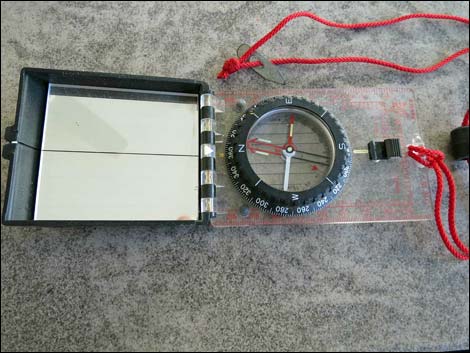 |
2. Compass A compass will never fail you, but you've got to know how to use it. Learn basic compass-craft from the web or your local library. These days I leave my compass at home and just carry a GPS unit, but I run the risk of it failing. I had a GPS that failed when it got too hot, and it seems that sometimes the entire satellite system goes down for a few minutes at a time. I think I can find my way well enough using the sun and stars, so I feel safe with the electronic unit, but I have a watch with a compass that is good enough to tell the cardinal directions. Also, if you are lost in the mountains around here, the default direction is downhill. Always go downhill unless you know for sure that there is a better direction (in which case you aren't really lost). If you go downhill, you will eventually get out of the mountains and hit a road. |
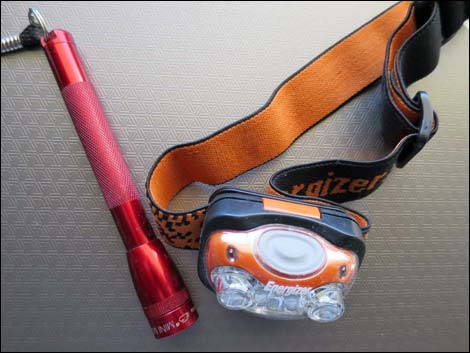 |
3. Flashlight (with extra batteries) We all expect to get off trail before dark, but it doesn't always happen. Carry something small and light, like a one-battery penlight or a little headlamp. A small light would usually be sufficient, as you don't need to light up the woods, just the area around your feet. Also, you will find that after your eyes adjust to the darkness, the starlight is pretty bright in the desert. I walked off a desert peak one night with just the light of the moon (no trail). |
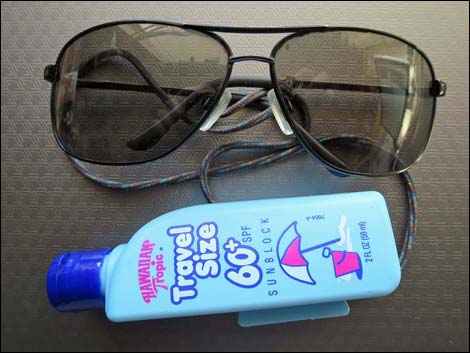 |
4. Sunglasses and Sunscreen Ultraviolet light will give you cataracts and skin cancer, so protect your eyes and skin. Also, long sleeves and long pants reduce exposure to the sun and reduce evaporative water loss. |
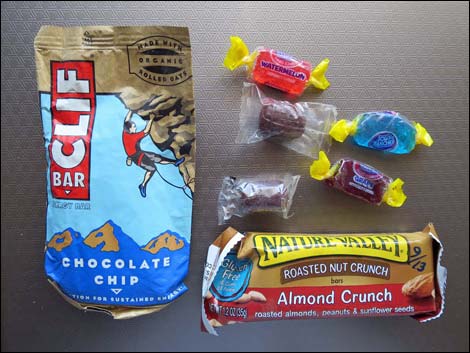 |
5. Extra Food and Water We all expect to get off the trail on time, but it doesn't always happen. During summer, carry one gallon of water per person per day; scale back from this during other times of year. I often start hikes with an extra water bottle in my hand and carry it for as long as I can. Then I cache it for the hike down. That way I don't have to conserve my water because I know that there is extra water waiting for me somewhere down the route. For food, don't shy away from high carbohydrate, salty foods. |
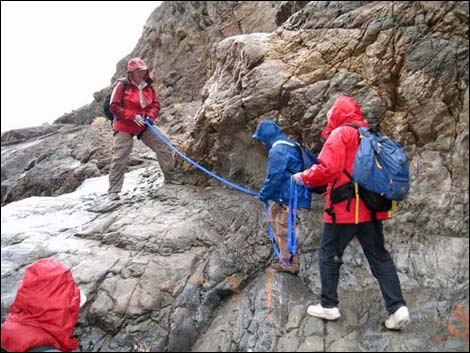 |
6. Protective Clothing (raingear, hat, mittens, sweater) It is always better to carry too much gear than to freeze. Carrying extra gear adds weight to your pack, but it widens your margin of safety. Carry light-weight layers so that you can match your clothes to the conditions. Even if you are just going for a day hike, consider what you will need to survive the night if you get stuck out overnight. |
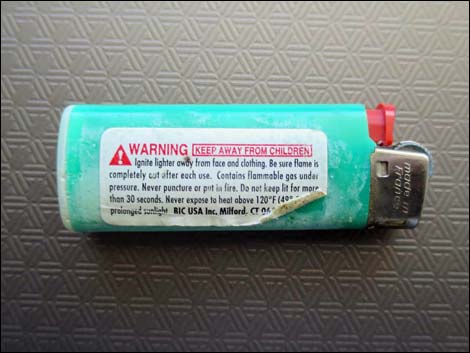 |
7. Matches (waterproof) Bic lighters are handy too. Of course, matches won't do you much good if you don't know how to light a campfire: you can't just put a match on a log. You need fine fuels (e.g., pine needles, wood shavings, or tiny twigs) to catch the spark, twigs and small sticks to get the fire started, and finally you need larger branches to keep it going. You also have to arrange the fuels properly and leave room for air to get to the sticks. Arranging your fuels in the shape of a tepee with fine fuels in the center, twigs around the fine fuels, and larger sticks around the outside. Logs usually make lots of smoke and little fire, so use smaller sticks and keep tossing them on. If you keep the fire small, you need less fuel, and you can stay warm by sitting a little closer to the flames. Learn basic fire-craft from the web or your local library. Always be careful with fire and follow local fire restrictions (fires are not permitted in the Mt. Charleston Wilderness Area). |
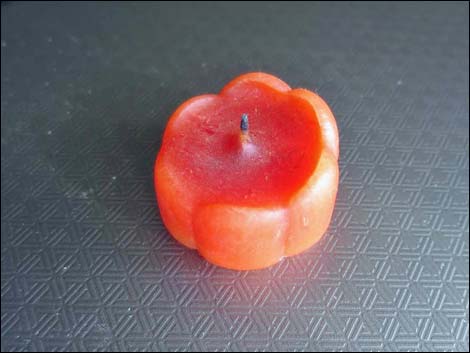 |
8. Candle for Fire Starting A candle will last longer than a match, and you can drip wax on your fine fuels, which is similar to dripping kerosene on your wood. Some people melt wax and mix it with sawdust or wood shavings to create small balls of fire-starter. |
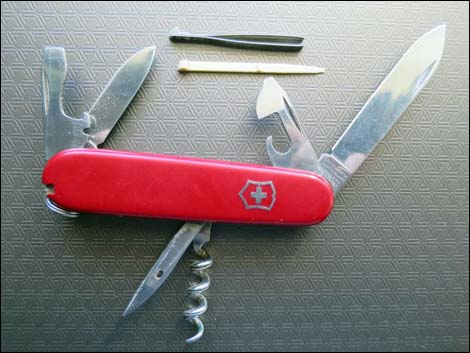 |
9. Pocket knife You don't need a big knife to fend of bears and wolves, just a sharp little folding knife. Your knife should be small enough and light enough so that you will always carry it in your pocket. I carry a Swiss Army knife with two blades, a screwdriver, can opener, bottle opener, cork puller, saw, drill, tweezers, and a toothpick. Don't leave home without it. |
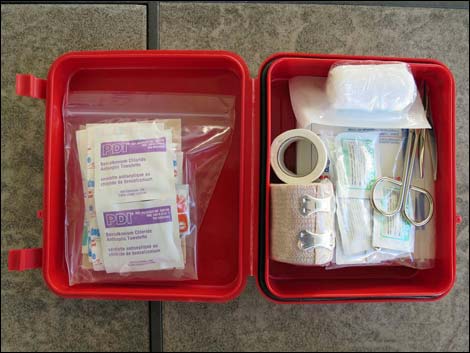 |
10. First Aid Kit Carry at least the basics, which for me is a roll of 1-inch cloth tape and an ace bandage. My shirt will make a good bandage, sticks will make a splint, and the tape will hold it all together. For longer trips, my first aid kit includes: cloth tape, salt tabs, nail clippers, Pepto-Bismol tabs, needle and thread kit, benadryl itch relief stick, band aids, forceps, Motrin tabs, antibiotic, and two Ace bandages. Learn basic first aid from the web or your local library. |
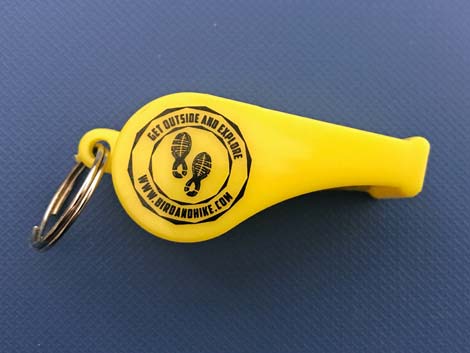 |
Extras: Whistle According to Paula, a whistle should be mandatory for all hikers, I've even had to use mine on easy trail hikes with meet-up when I lost the group due to a photo (or pee) detour... Many day packs have an integrated whistle built into the chest strap (smart design). |
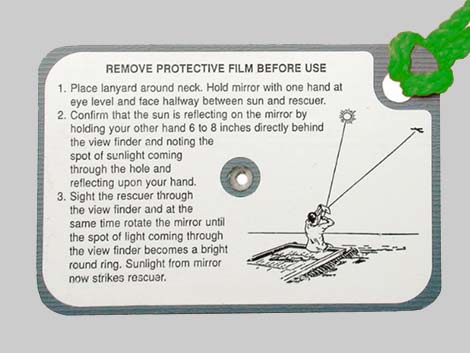 |
Extras: Signal Mirror Also according to Paula, a mirror is a small and easy thing to carry and is very helpful to signal search and rescue planes. |
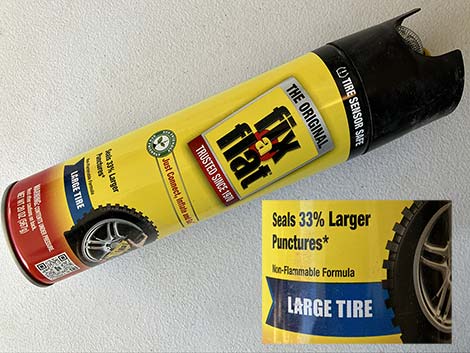 |
Extras: Tire Repair Kits The easiest Tire Repair Kit is a can of Fix-A-Flat. Out on the backroads, when I get a flat, this is always my first choice for getting back on the road. I once fixed a sidewall gash using two cans of Fix-A-Flat. |
Happy hiking! All distances, elevations, and other facts are approximate.
![]() ; Last updated 250120
; Last updated 250120
| Hiking Around Las Vegas | Glossary | Copyright, Conditions, Disclaimer | Home |